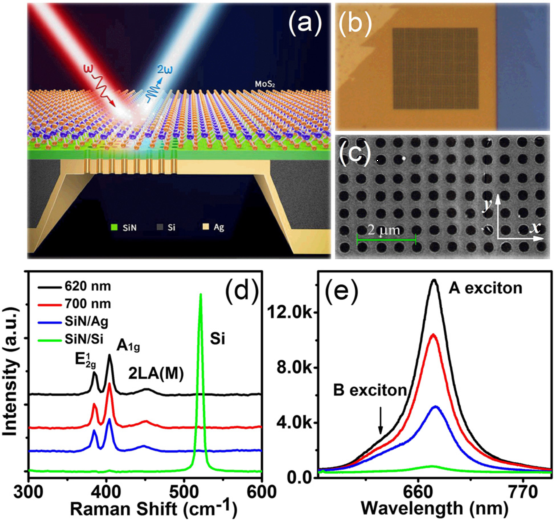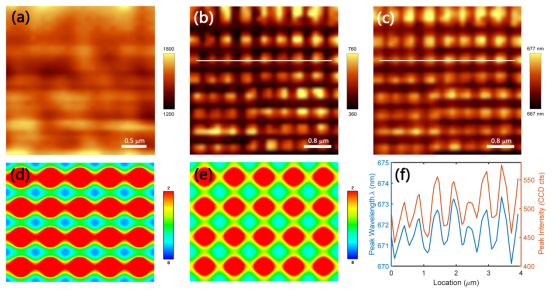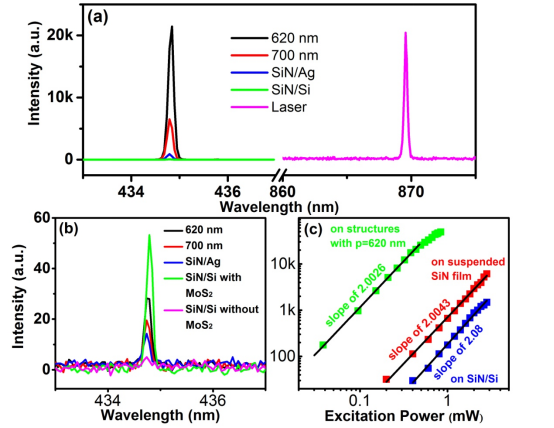二维材料是指仅有原子层厚度的晶体,例如石墨烯(Graphene)、单层过渡金属硫化物(Transition metal dichalcogenides: TMDCs):二硫化钼、二硫化钨等。和传统的材料相比,二维材料独特的能带结构和单层或少层原子厚度特征而具有丰富的电学、光学、力学和热学性能,在光电子学领域具有重要的应用。如可用于制备晶体管、光探测器、谷自旋电子器件、非线性相干光源等。然而,它的亚纳米尺度的厚度,减小了光与二维材料的相互作用距离,使其光学性能降低,限制了它的应用。
在人工设计的金属微结构上激发的等离激元共振,能够有效地把光场压缩在金属附近数十纳米处,致使金属表面处具有超强的电场强度和极小的模式体积,从而增强光与附近物质的相互作用。因此,把金属微结构和二维材料结合起来形成的杂化系统,利用微结构优异的电、磁共振性质,调控二维材料的光学效应,为二维材料的应用提供了新的思路和途径。
武山课题组设计了一种MoS2-SiN-Plasmonics系统,创造性的把金属结构的制备和二维材料的转移放在了悬空介质的两边,有效的避免了互相污染,同时可以有效增强单层MoS2的光学性质。例如,精细设计金属结构,让其激发的等离激元共振频率和激发光一致,可以有效增强二硫化钼的拉曼和荧光信号,使其平均发射的荧光强度提高了2个数量级,比大部分文献中报道的效果要好。此外,通过数值模拟和实验结果对比,获得了金属结构量子效益提高的数据。研究结果发表在中科院一区SCI杂志Nanophotonics 10, 975-982 (2020),IF:7.491。文章链接:https://doi.org/10.1515/nanoph-2020-0545。如果表面等离激元共振频率与泵浦光(869nm)一致时,能够获得超高的二次谐波(434.5nm)产出。与在硅上相比,二次谐波增强的3个数量级。研究结果发表在中科院一区杂志Nanophotonics 10, 1871-1877 (2021)上,文章链接:https://doi.org/10.1515/nanoph-2021-0030。
该工作主要依托于信息功能材料结构与器件安徽普通高校重点实验室,并与南京大学合作完成。第一作者为研究生,通讯作者为武山老师。信息功能材料结构与器件重点实验室致力于研究信息功能材料与器件的前沿课题,主要在低维功能材料与量子器件、光子学材料与器件等领域开展科技创新,探索新型多功能电磁信息元器件,拓展功能材料与器件的研究深度和广度,并取得了一系列相关成果。

Figure 1: (a) Schematic of our designed sample for detecting second-harmonic generation (SHG) signal. (b) Optical microscope image of the sample with the size of 21.7μm × 21.7μm. (c) Scanning electron micrograph (SEM) of the structure with P = 620 nm, respectively. (d) The Raman spectra and (e) PL spectra of monolayer MoS2 on the different substrates.

Figure 2. The measured A-exciton PL intensity mapping (a-c) and calculated total electric field distributions (d-e) of themonolayer MoS2 loaded SPM structure with different periods, respectively. (f) The A-exciton PL peak intensity (orange) and wavelength (blue) profiles along the indicated white line in (b).

Figure 3. Nonlinear SHG microscopy. (a) SHG spectra of monolayer MoS2 on the different substrates (metallic structures with P = 620 nm (black) and P = 700 nm (red), SiN/Ag (blue) and SiN/Si (green) substrate) and typical spectrum (pink) of fundamental laser. (b) SHG spectra of the different substrates without monolayer MoS2. As a reference, SHG spectrum (green line) of the SiN/Si substrate with monolayer MoS2 is also plotted in (b). (c) The dependence of the SHG intensity from monolayer MoS2 on different substrates on the excitation power plotted in log-log scale. Quadratic linear fit is displayed by the black line.
(撰稿、图片:武山 学院审核:朱勇 宣传部初审:张书光 终审:王清)